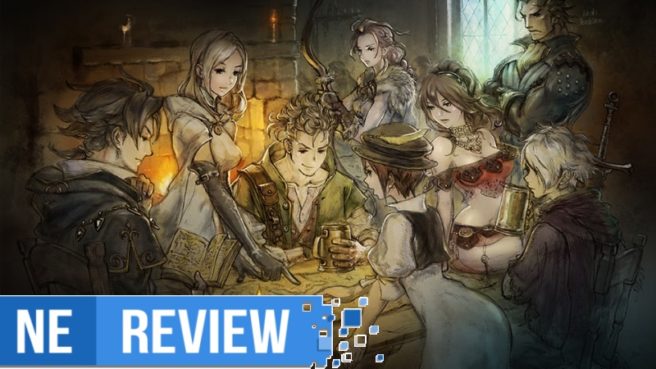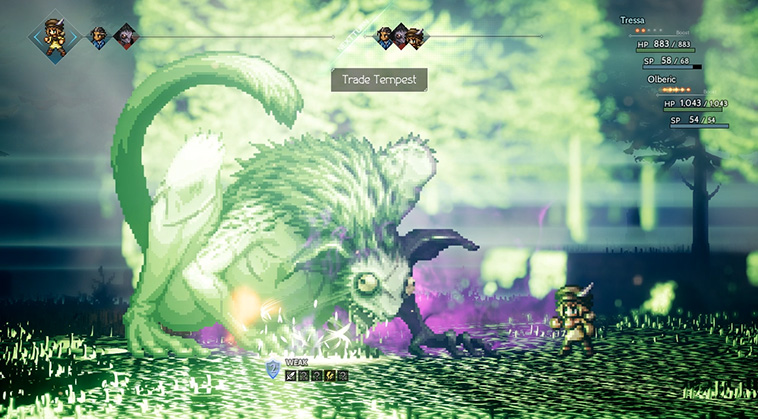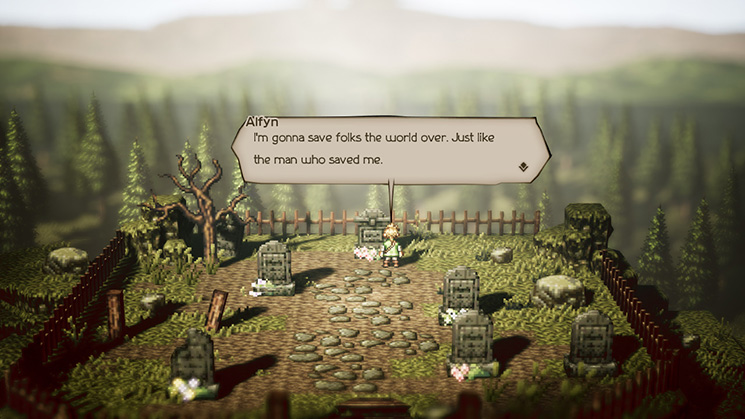[Review] Octopath Traveler
System: Switch
Release date: July 13, 2018
Developer: Square Enix / Acquire
Publisher: Nintendo
When Octopath Traveler was first pitched at Nintendo’s January 2017 Switch unveiling event, Square Enix’s brief trailer talked up a classic-style JRPG something akin to The Canterbury Tales. Its focus on the stories of eight travelers with its key art of each character exchanging tales in a pub evoked the timeless format of Chaucer’s narrative poem. For a less distant comparison to this style of fantasy RPG, Octopath Traveler pitched something closer to tabletop role playing games. *You* choose your path. In a very loose sense, this remains true. The game has an unconventional structure where you do pick the characters and the order that you want to play their stories out. Once you lock yourself into one of the game’s roughly hour-long story chapters, they play out linearly with no room for meaningful deviation and almost no regard for the unique path you’ve taken to that point. The final game, as it turns out, makes very little use of what could have been a very ambitious project of offering player-driven crossover stories. Realistically, this idea was probably always too ambitious for a game of this style. As glaring as the dissonance between story and play often is, it’s more productive to look at what Octopath Traveler gets right, rather than what it doesn’t prioritize.
Octopath Traveler does a lot right. Its soundtrack is exceptional (which is something I value particularly highly in a JRPG), and its unique HD-2D art style is an inventive throwback to classics in the genre – that is, when it doesn’t occasionally suffer from looking like someone applied a few too many Instagram filters to the game world. Then, there’s the meat and potatoes; its battle system is one of the most gratifying and refined in any JRPG of its ilk.
The battle system dips its hand in all the best pies, and it borrows ideas from an array of turn-based RPGs. On a fundamental level it can be understood as any basic turn-based system. Player characters and enemies take turns performing a single action per turn. Turns are visualized as a timeline on the top of the screen similar to Grandia and Final Fantasy X, showing the exact sequence that your party members and enemies will act and as per usual, this order is decided primarily by character statistics. Then, Ocotopath adds its break system on top of this. If you attack an enemy with a corresponding elemental and weapon-type weakness you will whittle away their defenses. When an enemy is broken, they won’t attack for a turn and they will be left wide open to high damage attacks. For regular enemies, this is usually an opportunity to unleash the finishing blow with an attack that has been charged with points that accumulate each turn, another more ancillary system that’s not unlike Bravely Default’s brave points. These two or three basic game mechanics make for an empowering gameplay loop for regular random encounter enemies, especially as you tweak your party setup to maximize on the weaknesses among enemies in a given area.
Boss battles are where Octopath Traveler’s gameplay systems have room to show their comprehensive breadth. Unlike regular encounters, a foe can’t be completely wiped out the first time you break them, so the strategic elements of this system expand. Now it gains a new rhythm where you have to account for a counterattack after the boss recovers from having broken defenses. On their recovery turn, a boss will always get two free moves before anyone in your party has a chance to act, and as a battle progresses and a boss shifts its strategy, it will gain more turns in retaliation to being broken, as well as complicating the steps it takes to break it. It strikes a beautiful balance between building an appropriately equipped party for the encounter while still leaving room for strategic improvisation. There are dozens of story bosses – and they’re all enjoyable in their own right – but the game pulls its punches while you experience the stories of each traveler. Once you complete all of their main stories and you’re ready to take on the high level post-game dungeons and bosses (each with their own worthy rewards), the game will let you bash your head against a enemy until you build a perfect team and a sound strategy to deal with what can initially seem like impossible odds.
When Octopath has its post-game difficulty spikes, it’s not for want of getting higher level. The game’s nonlinear structure means that a character’s level isn’t balanced to be as important as how they are equipped and how effective you are at juggling its mechanics. As with most well designed JRPGs: if you feel the need to grind for levels, then you’re probably doing something wrong.
Its story is a low point, but this critique of Octopath Traveler is relative. There is plenty of glaring missed opportunities with how its nonlinear gameplay design doesn’t inform its narrative design. An simple example is in the first chapter of Therion’s story. Therion is the thief character of the group, and he carries a lot of emotional baggage from his best friend’s betrayal years ago. He’s a lone wolf who (in cutscenes) refuses the help of fellow thieves when he resolves to rob an aristocrat’s mansion. If I come do his story when I already have a party of three other travelers, then we’ll all go through the mansion gameplay dungeon together. None of Therion’s dialogue is altered to reflect his new buddies, and the other party members won’t appear in cutscenes. When a boss at the end of a chapter is supposed to be a duel, the game will ignore this for gameplay contrivances and give the dueling character a full party as usual. I am willing to overlook this narrative dissonance most of the time, but it can get confusing to know what’s actually supposed to be canon these storylines when the game prompts you for contextual story-related conversations between party members that are otherwise not supposed to be involved.
A lot of Octopath Traveler’s strongest narrative design comes through in its path action mechanic. All eight travelers have a unique way to interact with NPCs. In effect there are really four abilities, each with two versions. Therion can steal with a chance of failing, whereas Tressa the merchant can purchase from the same pool of items that an NPC has on-hand. The other three actions are to have an NPC follow you and be summoned into battle, to challenge a NPC to combat, or to inquire into details of their life. Along with the expected “I am a guard and I watch the city” style of NPC dialogue, these abilities give a certain flavor and tell their own stories. Whether it’s something as simple as a threatening debt collector having poison in his pocket when you look into stealing from him, or a more elaborate, completely incidental side story when interrogate the lives of different family members throughout a village. It all remains internally consistent and they never miss an opportunity to wink and nod at the player through these little interactions.
The actual stories between all eight travelers are overall pretty strong. There is a lot of variety between the tones they strike. Tressa, one on the end of the tonal spectrum, is a bubbly merchant girl who’s just out to see the world before she settles down at her family’s shop. Even as I fully expected to hate her given my past experience with similar character archetypes in JRPGs, I ended her story thinking it was overall a really nice, sweet story rather than the sickly saccharine I’ve come to expect. Primrose’s story is the other end of tone, brooding and dark all the way through. Again, even though this might sound like I’m conjuring up images of Evanescence Final Fantasy VII: Advent Children AMVs, it’s not at all insufferable. The key to this, I think, is that each story keeps its scope relatively small and its stakes personal, but insignificant to the larger world. The writing often still reads like a JRPG, but a character’s glum is never unwarranted, and pep never fully takes over a different character’s emotional register. I struggle to say that it’s necessarily better writing than most JRPGs. What it does have are characters that are at least believably human. It works within the tropes of the genre but it’s not bogged down by them like a hall of mirrors, endlessly reflecting indistinguishable archetypes.
The Verdict
Octopath Traveler does almost everything right. Its throwback art style is beautiful, its soundtrack stands among the best of the genre, and its battle system borrows from the best ideas of the last few decades of turn-based RPGs and creates a layercake of systems that holds up to high-level strategic play. Even if it undeniably fails in aspects of how it tells its story, the substance of that story is a step above the average JRPG with characters that feel human despite their archetypical first impressions. Octopath Traveler is one of my favorite JRPGs of recent memory, taking the crown from the Bravely Default among the selection of throwbacks that the genre has seen over the last five years.
Octopath Traveler review copy provided by Nintendo for the purposes of this review.




